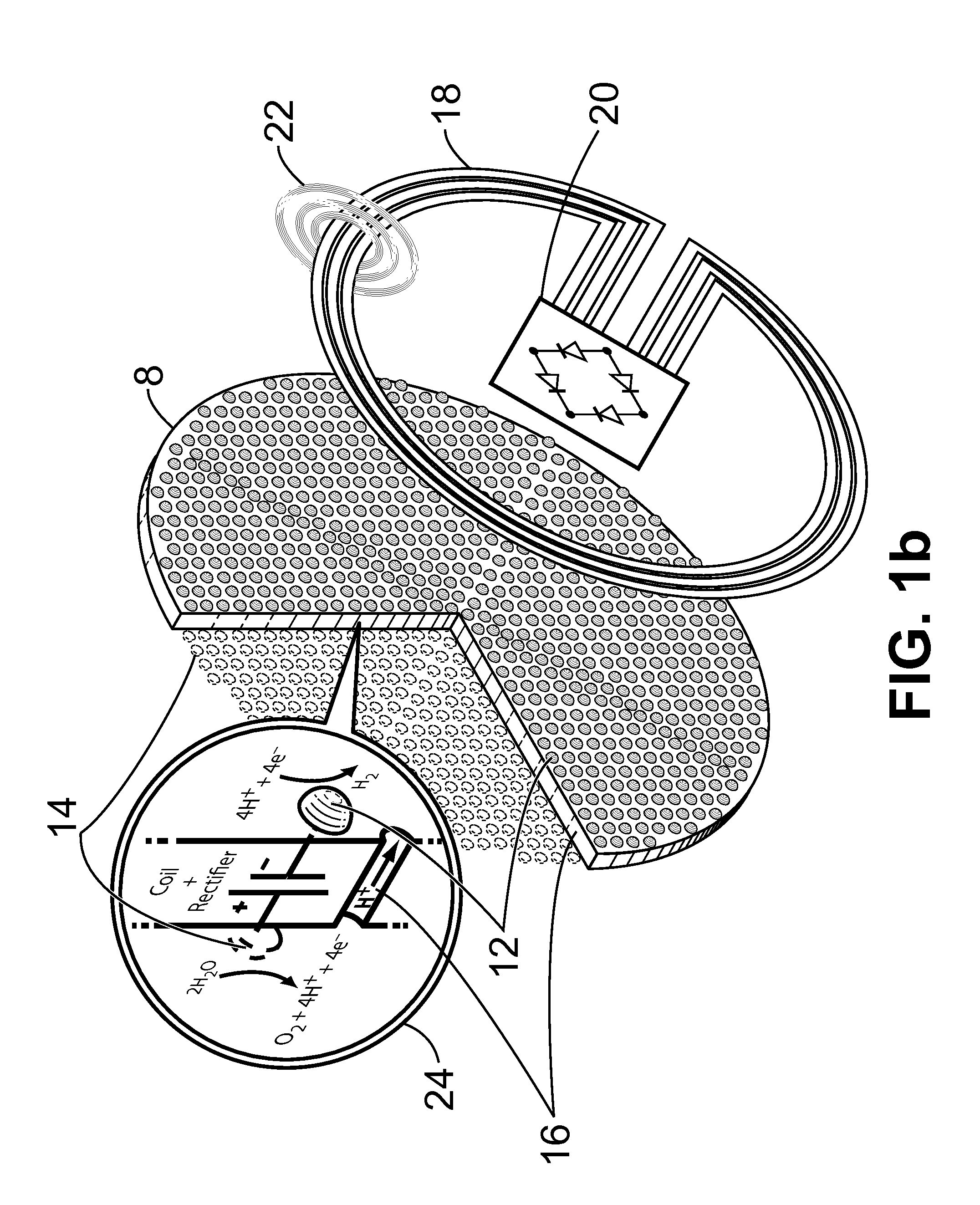Apparatus and Method for the Electrolysis of Water
a technology of electrolysis device and water, which is applied in the direction of hydrocarbon oil refining, oxygen compound preparation by reduction, energy input, etc., can solve the significant disadvantages of relying on non-renewable and polluting resources, prohibitive cost of current precious metal electrodes, and non-competitive electrolysis process with conventional hydrocarbon processes. achieve the effect of reducing the amount of electrocatalytic precious metal, maintaining efficient hydrogen production, and cost-effective and efficien
- Summary
- Abstract
- Description
- Claims
- Application Information
AI Technical Summary
Benefits of technology
Problems solved by technology
Method used
Image
Examples
example 1
Microelectrode System on Silicon Wafer Substrate
[0142]FIG. 10 is an illustration of a 4″ diameter silicon wafer 8 with 500 μm diameter etched pores 16 on a 2 mm center-to-center grid. The thickness of the wafer is 500 μm. Three photolithographed cathodes 36 are illustrated on the near side of the water. Three photolithographed anodes (not visible in FIG. 10) are in mirror positions on the reverse side of the wafer. Electrically conducting traces 38 connect bond pads 40 to the cathodes and anodes on either side of the wafer. Bond pads 40 are less than a millimeter away from the circumference of the wafer. Traces 38 are coated with an insulating layer. Test clips 56 connect the bond pads to a constant current source In the experiments used to obtain the test data, the wafer of FIG. 10 is gasket-sealed in a two-compartment chamber. Electrolyte fills the chamber to a level above the pores 16. However, the bond pads 40 are not immersed in the electrolyte. They protrude beyond the gasket ...
example 2
Test Run Data for the Microelectrode System
[0146]FIG. 12 shows the data for a test run on the microelectrode system described in Example 1. A 500 μA current was applied to the center pair of electrodes for the wafer of FIG. 10, which is also illustrated in the inset to the figure. The experiment began by sparging the system with high-purity nitrogen to eliminate dissolved atmospheric oxygen from the electrolyte. This provided the initial zero baseline for the hydrogen and oxygen detectors. The nitrogen flow was then turned off, thereby providing a quiet, static electrolyte in both chambers. Baseline data (at 0 μA) were recorded for about 37 minutes, as shown in FIG. 12. The carrier gas that transported H2 and O2 to the sensors flowed above the headspace and did not disturb the quiescent liquid in the chambers. Calibrated hydrogen and oxygen detectors were both located on the hydrogen side of the wafer. The rate of hydrogen production from the 500 μA current was observed using a tin-...
example 3
[0149]Another experiment was performed with a silicon wafer similar to that described in Example 1 (i.e., FIG. 10). Data for this experiment is shown in FIG. 14. The experiment was conducted similarly to that of FIG. 12, except that the wafer electrode assembly of FIGS. 4a and 4b (see inset to FIG. 14) was used in conjunction with the apparatus of FIG. 11. The silicon wafer contained the same pattern of pores, but no patterned electrodes on the surface. The electrodes in this experiment were movable platinum wires that were inserted into the cathode and anode chambers via septum ports, as illustrated in FIG. 11. FIGS. 4a and 4b depict a testing protocol for further demonstrating the utility of the present invention. Element 28 is a silicon wafer with pores. An insulting layer of silicon oxide coats 28. Element 30 is the ensemble of pores. Element 32 is an insulated wire with an exposed metal cathode. Element 34 is an insulated wire with an exposed metal anode. Cathode and anode abut...
PUM
| Property | Measurement | Unit |
|---|---|---|
| Time | aaaaa | aaaaa |
| Power | aaaaa | aaaaa |
| Current | aaaaa | aaaaa |
Abstract
Description
Claims
Application Information
 Login to View More
Login to View More - R&D
- Intellectual Property
- Life Sciences
- Materials
- Tech Scout
- Unparalleled Data Quality
- Higher Quality Content
- 60% Fewer Hallucinations
Browse by: Latest US Patents, China's latest patents, Technical Efficacy Thesaurus, Application Domain, Technology Topic, Popular Technical Reports.
© 2025 PatSnap. All rights reserved.Legal|Privacy policy|Modern Slavery Act Transparency Statement|Sitemap|About US| Contact US: help@patsnap.com



